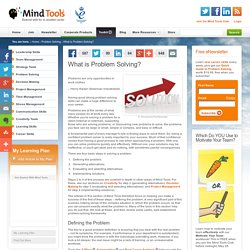

Drill Down Technique - Problem Solving Skills from MindTools.com. Breaking Problems Down Into Manageable Parts © iStockphoto/lurii Drill Down is a simple technique for breaking complex problems down into progressively smaller parts.

To use the technique, start by writing the problem down on the left-hand side of a large sheet of paper. Next, write down the points that make up the next level of detail on the problem a little to the right of this. These may be factors contributing to the problem, information relating to it, or questions raised by it. For each of these points, repeat the process. Drilling into a question helps you... ... for the complete article: Mind Tools Club members, click here. Join the Mind Tools Club to finish this article AND get 1,000 more resources Join now for just $1, first month "When I started using Mind Tools, I was not in a supervisory position. Join the Mind Tools Club Now and Get Our People Skills Workbook FREE Access training, help and ideas to boost your career.
Find out more. What is Problem Solving? - Problem Solving Skills from MindTools.com. © iStockphoto/PerlAlexander Problems are only opportunities in work clothes. – Henry Kaiser (American industrialist) Having good strong problem solving skills can make a huge difference to your career.

Problems are at the center of what many people do at work every day. Whether you're solving a problem for a client (internal or external), supporting those who are solving problems, or discovering new problems to solve, the problems you face can be large or small, simple or complex, and easy or difficult. A fundamental part of every manager's role is finding ways to solve them. There are four basic steps in solving a problem: Defining the problem.
Steps 2 to 4 of this process are covered in depth in other areas of Mind Tools. The articles in this section of Mind Tools therefore focus on helping you make a success of the first of these steps – defining the problem. Defining the Problem The key to a good problem definition is ensuring that you deal with the real problem – not its symptoms. Problem-Solving Skills From MindTools.com. Design and Research. January 2003 (This article is derived from a keynote talk at the fall 2002 meeting of NEPLS.)

Visitors to this country are often surprised to find that Americans like to begin a conversation by asking "what do you do? " I've never liked this question. I've rarely had a neat answer to it. But I think I have finally solved the problem. I don't consider myself to be doing research on programming languages.
The difference between design and research seems to be a question of new versus good. What I'm going to talk about today is what your target looks like from the back. The biggest difference is that you focus more on the user. Notice I said "what they need," not "what they want. " The customer is always right in the sense that the measure of good design is how well it works for the user. And yet, making what works for the user doesn't mean simply making what the user tells you to. If good design must do what the user needs, who is the user? Over in the arts, things are very different. A level index page.
D&T Online:Main menu.